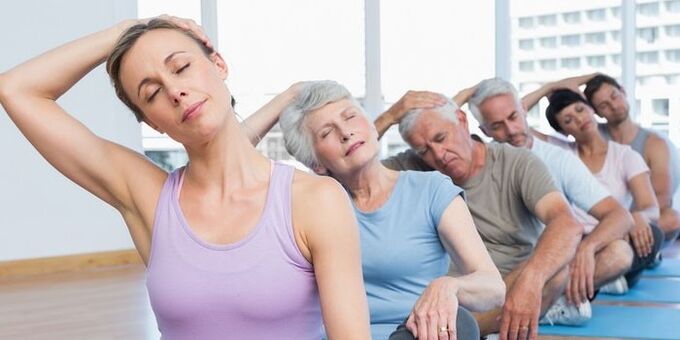Sedentary work, spinal injuries, overweight - there are many reasons why osteochondrosis develops (dystrophic disorders in the intervertebral discs). Pathological changes develop over the years, gradually being felt with tingling in the hands, burning sensation between the shoulder blades, neck pain and other unpleasant symptoms. You can help yourself if you start training on time.
The benefits of therapeutic exercise for osteochondrosis of the cervical spine
Until recently, osteochondrosis of the cervical spine was considered an age-related disease, but today the disease has become much younger and can occur even in patients aged 20-30 years. It is impossible to completely get rid of dystrophic disorders, but well-chosen treatment significantly improves the quality of life of the patient. One of the leading places in the treatment of osteochondrosis is occupied by the therapeutic and physical training complex (LFK). Simple exercise has many advantages:
- They help strengthen the muscular corset, increase muscle tone and elasticity of ligaments, thus significantly reducing the load on the spine.
- Regular exercise relieves neck pain, headaches, burning sensation between the shoulder blades.
- Gymnastics with cervical osteochondrosis activates blood flow, reduces the likelihood of stroke and increases the supply of oxygen to the brain.
- Classes in the early stages allow you to stop the progression of the dystrophic process, to improve posture.
Indications and contraindications
Charging with osteochondrosis is prescribed in remission, when the pain subsides. Helps relieve exacerbations, prevents the development of recurrent attacks of pain, complications and further destruction of the joints. Patients with minor spinal injuries, diabetes mellitus, hypertension should perform the prescribed exercises in a light version and initially only under the supervision of a doctor or coach.
You should not start exercising immediately after eating, on an empty stomach or after strenuous exercise. Physiotherapy exercises are also contraindicated in the presence of the following pathological conditions:
- hypertension;
- arrhythmia, tachycardia;
- glaucoma, severe myopia;
- diseases of the vestibular apparatus, which are accompanied by impaired coordination;
- infectious lesion of the spine;
- period of exacerbation of osteochondrosis;
- aortic aneurysm;
- post-infarction condition at the stage of early rehabilitation;
- severe spinal injuries;
- acute respiratory viral diseases.

Implementing rules
Before you start gymnastics with cervical osteochondrosis, it will be useful to get acquainted with the general rules of physical education:
- The exercise should be performed in a well-ventilated room.
- Training clothes should be loose, not restrict movement and uncomfortable.
- Before training you should measure your heart rate and blood pressure, in case of increase, refuse to perform exercises.
- To reduce the risk of injury, all movements should be performed smoothly, gradually increasing the load, intensity and number of repetitions, while maintaining your posture.
- Exercise with cervical osteochondrosis should be done regularly. Many exercises are suitable for doing work while studying.
- If during the training therapy you feel sharp pain, dizziness, you start to feel sick, immediately stop further exercises and sit down to rest. In the future, reduce the load and consult a doctor.
- In addition to exercises, courses of therapeutic massage and physiotherapy may be prescribed.
Exercises for cervical osteochondrosis at home
Therapeutic gymnastics involves performing a series of simple exercises. With the permission of the doctor, they can be performed at home with relaxing music. The main condition is that the spine is as flat as possible, so it is preferable not to lie down, but to practice standing or sitting on a chair without a back. For a lasting therapeutic effect, do gymnastics at the same time every day.
What is the warm-up for?
An important part of any physical activity is muscle preparation. A light warm-up will help to avoid injuries, warm up the muscles, prepare the body for the start of intense training, improve blood circulation and stretching. Sample set of exercises:
- Sitting in a chair with a straight back, relax and lower your arms along your torso. Make circular movements with your shoulders, first forward, then backward. Do 5-10 reps on each side.
- Stay in the same position, spread your arms parallel to the floor. Inhale and bend your elbows, gently touching your shoulders with your fingertips. With the exhale, return to the starting position. Make 10 extensions.
- Stand up straight, place your palms on your shoulders, elbows parallel to the floor. As you count one or two, begin alternating circular movements with your elbows. First, with your right hand, reaching the end of the circle, connect your left elbow. Make 5 rounds for each hand.
- Take a starting position, as in the first exercise. Squeeze your arms, start moving your shoulders back and forth. Repeat the procedure 10 times for each side.
Isometric exercises for the neck with osteochondrosis
This complex includes performing all exercises without moving the head or neck - only with the help of muscle tension. Isometric gymnastics for cervical osteochondrosis is considered the safest, and is therefore prescribed to patients to relieve pain during exacerbations. All exercises are performed from a position: standing or sitting on a chair without a back. The duration of one task is 5 seconds, the number of approaches is 2-5. Examples of effective exercises:
- Put your fingers together and place your palms on your forehead. Start pressing your hands on your forehead, as if trying to tilt your head, resist with the muscles of the neck so that the body remains motionless.
- Move your arms in the same position to the back of your head. Pressing with your palms, make a micromovement of the head forward. At the same time, resist the arms with the muscles of the neck and forearms.
- Place your right hand on your cheek with the palm of your hand. Press your hand over your face, trying to tilt your head to the left. At the same time, tighten the muscles, not allowing the head to bend. Do the same exercise with your left hand.
- Stand up straight, feet shoulder-width apart. Hands aside, palms out. Tighten the muscles of the neck, arms and back. Gather your elbows, then back, trying to place your hands as far behind your back as possible. Bending and spreading the elbows is careful, without removing tension from the muscles and maintaining balance.
dynamic gymnastics
Physical education for cervical osteochondrosis must include exercises aimed at strengthening and increasing muscle tone of the upper limbs, neck, shoulder girdle and lower back. That is what dynamic tasks are for. They are all performed at a fast pace, there is a break of 10-15 seconds between series. You should know that dynamic gymnastics is contraindicated in exacerbations of osteochondrosis, diabetes, spinal injuries and cardiovascular disease.
Approximate set of exercises:
- Stand up straight, fold your legs, place your hands on your waist. Carefully tilt your head, try to reach the shoulder with your ear. Do 5-6 reps for each side.
- Sitting or standing, slowly raise your arms up with your palms together. As you exhale, slowly return to the starting position. Do 10-15 reps.
- Stand up, spread your legs, lower your arms along your torso. Make simultaneous circular rotations with your shoulders without raising your arms. Perform 15 circular motions in 3 series. To complicate it, you can make alternating circles - first with the left, then with the right shoulder.
- While standing, pull your right arm back with force, while raising your left arm up. Do 10 reps and 3 sets for each limb.
- While standing, lower your arms along your torso. Alternately make stroking movements, sliding to the side, lifting your shoulders as much as possible. Complete the task for 1 minute, then take a break and 2 more sets.

A set of exercises for osteochondrosis of the cervical spine
Many patients of the rehabilitation doctor successfully get rid of hypertension, osteochondrosis and other health problems with the help of neck exercises. The doctor claims that his physical education helps to improve blood circulation, develops the muscles of the neck and upper spine, prevents the development of heart attack and stroke. Gymnastics for cervical osteochondrosis will be useful during the rehabilitation period after surgery or injury and for those people who have the following pathologies:
- hypertension;
- drowsiness or insomnia;
- chronic migraines;
- memory impairment.
The author of the technique recommends that all exercises be performed from a sitting position. It is important to keep your back as even as possible and not to rush, otherwise you will not only not get positive results, but you will worsen your condition. To monitor your posture, initially run the program in front of a mirror. The training scheme is as follows: the first two weeks - every day, then 3-4 workouts a week.
Therapeutic gymnastics for osteochondrosis of the cervical spine has certain contraindications. Gymnastics cannot be done with:
- fever, malaise, weakness;
- exacerbation of osteochondrosis;
- oncological diseases;
- disc herniation;
- during pregnancy;
- infectious and viral diseases;
- risk of internal bleeding.
7 exercises for the neck and shoulders
The complex consists of seven tasks that must be performed while sitting on a chair without a backrest or other hard surface. All exercises for the treatment of cervical osteochondrosis are shown in the table below:
> zxtable border = "1" cellpadding = "0" >Therapeutic effects and results
Therapeutic gymnastics for osteochondrosis of the cervical spine helps to improve the course of the disease in a short time and with constant performance to treat osteochondrosis without medication. It is not at all necessary to immediately perform the whole wellness complex of the proposed exercises, beginners can choose those that are given to them without much effort and gradually increase the volume. After achieving therapeutic effects you should not stop exercising, the improvement of the condition should be maintained continuously.
In the absence of strict contraindications, you can stretch the spine on the horizontal bar. Such an exercise helps to put the intervertebral discs in place, gives strength, strengthens the muscular corset. Suitable for swimming, dancing, light fitness, yoga or aerobics. To prevent osteochondrosis and complete recovery, doctors recommend maintaining an active lifestyle and proper organization of the work space.
























